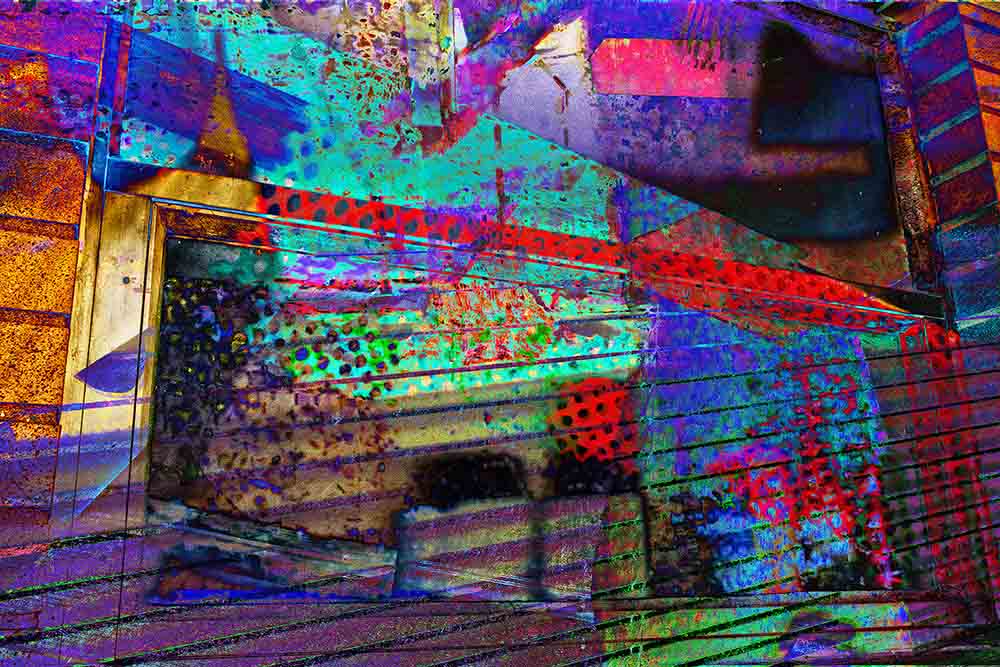NUNUMBlending Flash Fiction & ArtThe Art of Christopher Paul Brown
Monster at the Door II Alley Unconscious Dubuque by Christopher Paul BrownHenry the Lucky and His Bride II School Windows Unconscious Dubuque by Christopher Paul BrownTrap Door With Wiffle Ball or Witch and Gangster School Windows Unconscious Dubuque by Christopher Paul BrownInterview with Christopher Paul BrownChristopher, what was the first book you remember picking and reading by yourself? I was a precocious reader. My interest in science fiction and fantasy was well known by my parents and grandparents, so my early books were bought for me, such as Jules Verne and Tarzan of the Apes. I must have first found something on my own, but the recollection is lost. However, at age 10 I deliberately went outside my comfort zone and picked up In Cold Blood by Truman Capote at the library. It was eye opening. Nice assortment there, In Cold Blood was an important book for me here as well but I read it much later in life. What was the last book you read that made you say damn that was a good book? His Dark Materials by Philip Pullman What about on holidays, who are your go-to writers when you need something to read on holiday? Robert Harris, James Lee Burke, Erik Larsen, Lawrence Block Before we finish up with books Christopher I am curious, pen, pencil or phone which one do you reach for when you need to write something down? Pen. I am never without one. A man after my own heart, okay, let's switch to art for a bit, which contemporary artist do you most admire? David Hockney alone among the uber-successful. I like Peter Doig among the less successful. What about closer to home, is there an artist in your local community that you would recommend people check out? Noah Starr and Adam White. What about you Christopher, which artists have influenced your current artistic direction? Milton Avery, Georges Braque, Henri Matisse, Wassily Kandinsky, Jacques Henri Lartigue. Do you remember your first good photo? During winter break of my ‘77/’78 college year I bought a Contax RTS 35mm camera and a Zeiss lens. I carried it everywhere and shot a lot on the streets of Chicago’s loop. One day on Wabash I shot out of a cab (or the el train – it was a while ago) and caught a young man running. Later, with a loupe and the contact print, I saw that part of his image was blurred with motion and that made the image magic; all around him was a faithful, if black and white, reproduction of the scene of street, people and store. The blur alone was something the everyday eye doesn’t encounter. I hadn’t yet found Lartigue, yet I saw with that image that photography’s limits were where its best assets lay, and I felt inspired to play and dance around those limits. The image also confirmed that the camera was right for me. I later printed and framed the image and sold it to The Standard Oil Company of Indiana. It was my first sale as a photographer. Has your introduction to any particular artist stood out? I remember vividly sitting in the fourth grade while the “art lady” visited our class. She was a volunteer with an interest in art and would arrive armed with 8” X 10” prints of famous artwork and stories about the artists. The day she showed us a Wassily Kandinsky was a revelation to me. It was like the world changed and I could never go back to the previous normal. Subsequent artists rocked me, but never so much as that day in class. Why do you think it is difficult to make a living as an artist? The first reason is simply competition. So many people enjoy making art there is a supply/demand imbalance. Unlike becoming an accountant, a dentist or a money manager, where the demand approximates the supply, artist of all degrees of talent are happy to pay to have their art seen. Art is like competitive tennis; only the top 100 can make a living at it, while millions enjoy playing it. The second reason is that art has achieved an over-the-top exclusionary attitude by playing up mental concepts. This has left the average person with a distrust of their response to art, and that is exactly what the parasites making money in the arts want. The movers and shakers in the art world want to influence and even dictate fads and fashions. This mind-based engineering is entirely counter to real art. It is entirely dysfunctional; the art world mirrors our corrupt society. And finally, what advice would you give someone who is just starting to send their work out to journals? Investigate the journal. You want to submit your work to places that resonate with you. Find journals that contain works you like. NUNUMBlending Flash Fiction & Art
0 Comments
Your comment will be posted after it is approved.
Leave a Reply. |
AuthorNUNUM Archives
July 2024
Categories |












 RSS Feed
RSS Feed